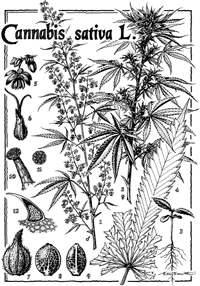Body's Own Marijuana-like Compounds Are Crucial For Stress-induced Pain Relief
Athens, Ga. -- A new study shows, for the first time, that the release of the body's
own marijuana-like compounds is crucial to stress-induced analgesia -- the body's
way of initially shielding pain after a serious injury.
The work, led by scientists at the University of Georgia and the University of
California, Irvine, may yield a target for new drug therapies that will completely
bypass the current arguments over the use of medical marijuana. In theory, the new
research makes it possible to design a pill that will have the same pain relieving
effects as smoked marijuana, but through an indirect mechanism that could also
reduce unwanted psychoactive side effects and not have the same political baggage.
"There is no prescription or over the counter drug that allows us to manipulate the
level of the brain's marijuana-like compounds," said Andrea Hohmann, a
neuroscientist in the department of psychology at the University of Georgia and co-
author of the paper. "This is the first time anyone has shown that one of the body's
naturally occurring cannabinoids, a compound known as 2-AG, has anything to do with
pain regulation under natural conditions."
The study was published today in the journal Nature.
Hohmann's co-author, Daniele Piomelli at the University of California-Irvine, is the
discoverer of a compound that blocks the breakdown of this marijuana-like compound
called 2-AG, and it is that blocking compound, patented by UC-Irvine, that could
become the new drug of choice for those suffering from pain or stress conditions.
Importantly, it would not require people to smoke marijuana to obtain relief or
wrestle with the legal issues surrounding the drug.
Others from UGA involved in the study include faculty members Philip Holmes and
Jonathon Crystal and students Richard Suplita, Nathan Bolton and Mark Neely.
Authors from UC-Irvine include Darren Fegley and Regina Mangieri, in addition to
Piomelli. Other co-authors are Jocelyn Krey and Michael Walker from Brown
University; Andrea Duranti, Giorgio Tarzia and Andrea Tontini from the University of
Urbino Carlo Bo in Italy; and Marco Mor from the University of Parma, also in Italy.
All were crucial in designing and synthesizing the enzyme inhibitor.
Scientists have long known that injured athletes or even gunshot victims have a
period of time in which the body's pain reaction is delayed. This effect is
called "stress-induced analgesia." By the mid-1990s, researchers had targeted the
sites of action of the brain's naturally occurring marijuana-like compounds as
having a crucial role in blocking pain, but no one understood the conditions in
which these compounds were released to block pain.
Researchers along the way found out there are two kinds of stress-induced analgesia
mechanisms, opioid and nonopioid (or "opioid independent"). Hohmann and colleagues
discovered that the opioid-independent form was produced by release of the brain's
own marijuana-like compounds.
"We showed that cannabinoid receptors were involved in this remarkable phenomenon,"
said Hohmann, "because blocking the receptors where marijuana acts virtually erased
this opioid-independent form of stress analgesia."
If this is true, was there a compound that could also prolong the action of these
compounds, making them work better? The answer lay in Piomelli's pioneering work on
inhibitors that break down the brain's own marijuana-like compounds.
"If we design chemicals that tweak the levels of these transmitter substances in the
brain," said Piomelli, "we might be able to boost their normal effects."
When rats used in Hohmann's study were given the compound developed by Piomelli and
his collaborators at the University of Urbino Carlo Bo and the University of Parma,
it increased stress-induced analgesia dramatically, proving the connection between
pain suppression and the release of these marijuana-like compounds.
The enzyme that inhibits the formation of the naturally occurring marijuana-like
compound 2-AG is called monoacylglycerol lipase, and it is this enzyme that could be
a target for therapeutic drug intervention to help those in pain.
A new drug increasing the body's own marijuana-like compounds could work similar to
something like Prozac, which blocks the body's reuptake of the compound serotonin,
causing it to be active longer, Hohmann said.
Apparently, several parts of the brain are involved in the effect, most notably a
structure in the midbrain known as the periaqueductal gray. In this region, stress
causes the release of the naturally occurring marijuana-like compounds in the brain.
A drug derived from the new research would likely be more effective and specific
than smoked marijuana, said Hohmann.
